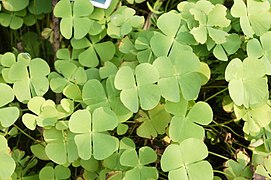|
Marsilea minuta
Marsilea minuta, or dwarf waterclover is a species of aquatic fern in the family Marsileaceae. It is not to be confused with Marsilea minuta E.Fourn. 1880, which is a synonym for Marsilea vestita.[4] Other common names include gelid waterklawer, small water clover,[1] airy pepperwort, and pepperwort,[7] though the lattermost also applies to plants in the genus Lepidium. In French it is called marsilea à quatre feuilles (literally "four-leafed marsilea")[7] and petite marsilée (literally "little Marsilea"),[1] the latter appearing to be a calque with the Latin botanical name. In Chinese it is 南国田字草 (nan guo tian zi cao),[8] literally "southern field word grass," referencing the similarity of the leaflet shape to the Chinese character for "field." The Koch Rajbongshi people and Garo people call it shusni shak.[9] It is called 'শুশনি শাক' ('shushni shak') in Bengali[citation needed]. In parts of India it can be called sunisanakka[10] In Indonesian it is semanggi (literally "clover"),[7] but this name also applies to Marsilea crenata. In Japanese it is nangokudenjiso and in Thai it is phakwaen.[7] In Malaysian it is tapak itik (literally "duck footprints").[7] In the Philippines it is kaya-kayapuan (literally "so crowded").[7] DescriptionM. minuta has a variable appearance,[5] which often leads to confusion with closely related species. In the water the plant is creeping and spreading, while on land it can appear cushion-like.[5] It typically is perennial but sometimes appears annual. It is a tenagophyte, with the juvenile growing submerged and the adult typically terrestrial.[5] It has a light brown to green rhizome that is 0.4–0.8 millimetres (1⁄64–1⁄32 in) thick with short tan hairs at the ends and internodal roots.[4] The land leaves are on erect, terete, 5–13 centimetres (2.0–5.1 in) long petioles.[4] The leaflets are 0.8–1.7 centimetres (3⁄8–5⁄8 in) by 1.2–2 centimetres (1⁄2–3⁄4 in), mostly glabrous, cuneate or flabellate.[4] The leaves in water are typically not floating, but emergent from the water.[4] Fertile leaves are produced on land with up to four sporocarps each at penduncles near the base of the petiole.[4] It has a small sporocarp that is 2.6–4.1 millimetres (7⁄64–5⁄32 in) long, 2.4–3.1 millimetres (3⁄32–1⁄8 in) wide, and 1.3–1.7 millimetres (3⁄64–1⁄16 in) thick.[4][11] The sporocarp has a superior tooth at the apex of the stalk and an inferior tooth at the base.[12][5] The sporocarp has a conspicuous 1.5–2.2 millimetres (1⁄16–3⁄32 in) long raphe,[4][12] about ⅔ the length of the sporocarp and semi-terete.[5] Unlike a few Marsilea species, M. minuta sporocarps mature above ground.[12]
TaxonomyM. minuta is thought to be closely related to Marsilea quadrifolia.[4] Molecular phylogenetic analysis of the genus Marsilea puts both in a widespread Old World subgroup also called "Marsilea" along with M. angustifolia, M. drummondii, M. crenata, and M. fadeniana and indicating that M. crenata is actually a synonym of M. minuta.[12][7] {{clade |label1=Marsilea subgroup |1={{clade |1={{clade
|1= |label2=M. minuta-M. crenata-M. fadeniana complex
|2={{clade
|1={{clade
|1={{clade
|1=
Habitat and ecologyMarsilea minuta can grow from sea level up to 1,950m in elevation[1] in ponds and other shallow water.[8] It can grow in fresh water or brackish water in clay or sandy soil.[4] The plant can develop into large colonies, and can be weedy.[4][11] Some of its preferred habitat is being lost to agriculture but as it readily grows in Paddy fields, drainage ditches, and other marginal areas its overall population is stable.[1] It has the potential to be invasive and dispersal through aquarium trade and other human means should be limited.[7] It is a native plant in the following countries:[1]
The leaves and sporocarps of M. minuta are eaten by many waterfowl species, and the intact sporocarps pass through undigested to be spread to new areas.[7] Elophila responsalis also feeds on the leaves, but is not thought to do much damage to the plant.[7] The plant is susceptible to herbicides such as bensulfuron-methyl, cinosulfuron, 2,4-Dichlorophenoxyacetic acid, oxyfluorfen, and paraquat.[7] Otherwise it can tolerate high levels of organic pollution.[5] UsesIt is eaten in India, Sri Lanka,[14] and in Bangladesh.[9] In China it is used as forage.[8] It has a raw protein content of 3.3%.[14] The plant is used traditionally in China for edema, skin injuries, snakebite, and inflammation.[8] In Mymensingh District it is traditionally used to treat cough, headache, hypertension, sleep disorders, and respiratory diseases.[9] It is combined with Nardostachys jatamansi and after development by Asima Chatterjee[15] sold as an ayurvedic treatment for epilepsy called "Ayush-56."[10] However, Ayush-56 does not show encouraging results in treating the disease.[16] It is also used as a phytoremediator of arsenic while growing with rice plants.[17][18] GalleryReferences
External links
|
||||||||||||||||||||||||||||||||||||||||||||||||||||
Portal di Ensiklopedia Dunia












